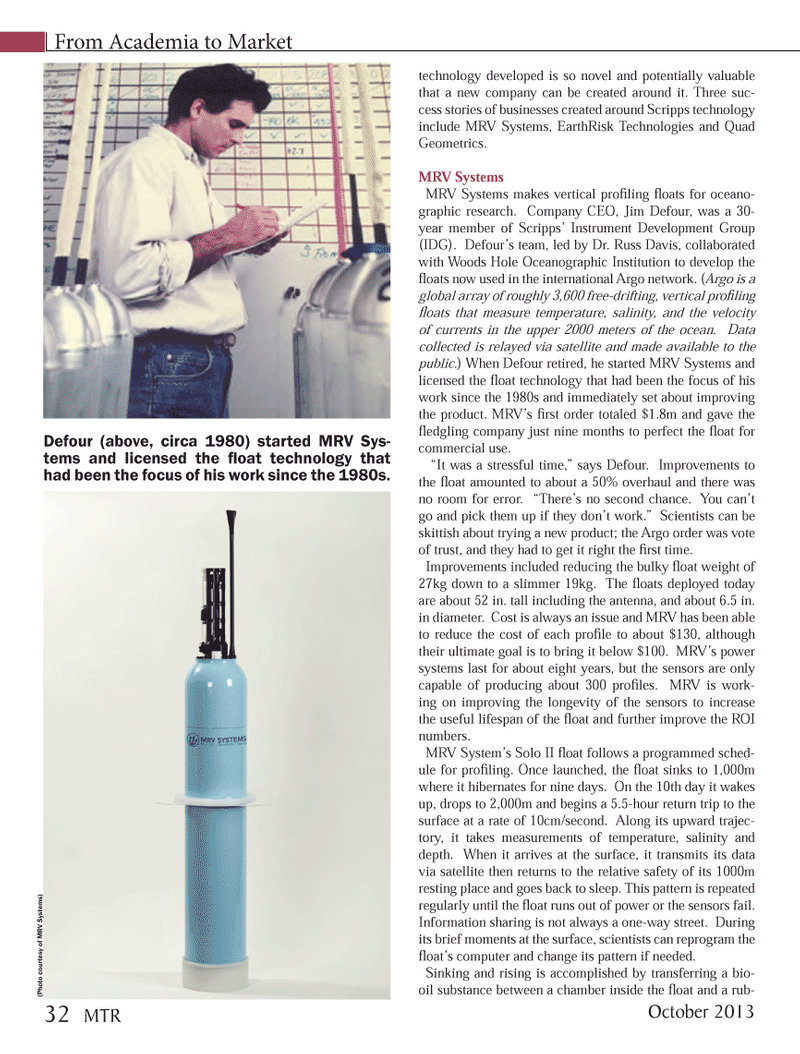
Page 32: of Marine Technology Magazine (October 2013)
Subsea Defense
Read this page in Pdf, Flash or Html5 edition of October 2013 Marine Technology Magazine
From Academia to Market technology developed is so novel and potentially valuable that a new company can be created around it. Three suc- cess stories of businesses created around Scripps technology include MRV Systems, EarthRisk Technologies and Quad Geometrics.MRV Systems MRV Systems makes vertical proÞ ling ß oats for oceano- graphic research. Company CEO, Jim Defour, was a 30- year member of ScrippsÕ Instrument Development Group (IDG). DefourÕs team, led by Dr. Russ Davis, collaborated with Woods Hole Oceanographic Institution to develop the ß oats now used in the international Argo network. ( Argo is a global array of roughly 3,600 free-drifting, vertical proÞ ling ß oats that measure temperature, salinity, and the velocity of currents in the upper 2000 meters of the ocean. Data collected is relayed via satellite and made available to the public.) When Defour retired, he started MRV Systems and licensed the ß oat technology that had been the focus of his work since the 1980s and immediately set about improving the product. MRVÕs Þ rst order totaled $1.8m and gave the ß edgling company just nine months to perfect the ß oat for commercial use. ÒIt was a stressful time,Ó says Defour. Improvements to the ß oat amounted to about a 50% overhaul and there was no room for error. ÒThereÕs no second chance. You canÕt go and pick them up if they donÕt work.Ó Scientists can be skittish about trying a new product; the Argo order was vote of trust, and they had to get it right the Þ rst time. Improvements included reducing the bulky ß oat weight of 27kg down to a slimmer 19kg. The ß oats deployed today are about 52 in. tall including the antenna, and about 6.5 in. in diameter. Cost is always an issue and MRV has been able to reduce the cost of each proÞ le to about $130, although their ultimate goal is to bring it below $100. MRVÕs power systems last for about eight years, but the sensors are only capable of producing about 300 proÞ les. MRV is work- ing on improving the longevity of the sensors to increase the useful lifespan of the ß oat and further improve the ROI numbers.MRV SystemÕs Solo II ß oat follows a programmed sched- ule for proÞ ling. Once launched, the ß oat sinks to 1,000m where it hibernates for nine days. On the 10th day it wakes up, drops to 2,000m and begins a 5.5-hour return trip to the surface at a rate of 10cm/second. Along its upward trajec- tory, it takes measurements of temperature, salinity and depth. When it arrives at the surface, it transmits its data via satellite then returns to the relative safety of its 1000m resting place and goes back to sleep. This pattern is repeated regularly until the ß oat runs out of power or the sensors fail. Information sharing is not always a one-way street. During its brief moments at the surface, scientists can reprogram the ß oatÕs computer and change its pattern if needed. Sinking and rising is accomplished by transferring a bio-oil substance between a chamber inside the ß oat and a rub-Defour (above, circa 1980) started MRV Sys- tems and licensed the ß oat technology that had been the focus of his work since the 1980s. (Photo courtesy of MRV Systems) October 201332 MTRMTR #8 (18-33).indd 32MTR #8 (18-33).indd 3210/15/2013 4:10:16 PM10/15/2013 4:10:16 PM

 31
31

 33
33
